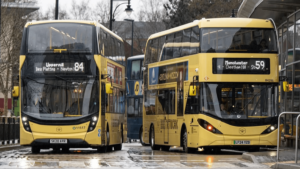Over the past 12 months, London has faced some major changes to travel, from a grinding halt in late March when the city came to a standstill, to the introduction of low traffic neighbourhoods in boroughs across the capital.
Air Quality News got in touch with Emma Gibson, director of watchdog London Travel Watch to discuss what the future of London’s transport network should look like.
According to Emma, one of the biggest issues facing transport in London is the question of priority.
For many years campaigners have been calling for priority to be reassessed, envisioning a city where cyclists and pedestrians can move about freely and safely.
According to Emma measures like the congestion charge certainly have a part to play in encouraging people to get out of their cars, but these measures also have to be backed up by ensuring that people have really good access to public transport or by making sure that they can walk or cycle safely.
‘The congestion charge is a really blunt instrument and it isn’t necessarily the fairest or most equitable method,’ said Emma.
Instead, Emma argued that the focus should be on expanding London’s existing public transport network and looking at road pricing schemes which reflect how many miles people drive, where they drive and what time of day.
Instead, Emma argued that the focus should be on expanding London’s existing public transport network.
‘Yes, people can cycle and walk more, but people will always need to travel long distances so that needs to remain a priority.’
‘In 2005, Transport for London (TfL) introduced free bus travel for under 18s and a recent study has shown that not only has this reduced car use in adolescence but that these trends continue as the individuals become adults.
‘It normalised bus use, and so resulted in less car dependence in later life.
‘This scheme has been on the bargaining table with the deal with TfL and the government but I think that’s a mistake. This is an example of a measure that achieved exactly the right behaviour change that people are hoping for.’
In the early stages of the pandemic, car-use dropped to record lows, with widespread reports of air quality dramatically improving as a result.
However, congestion levels have quickly bounced back to the same, if not higher levels than before.
‘It is no longer the case that people are getting in their cars because it’s convenient, it’s because they’re frightened.
‘Our weekly opinion poll showed that 37% of Londoners plan to increase their car use once the pandemic is over. That’s a really worrying trend and it underlines how important getting on top of traffic levels is.’
In a bid to tackle this, and encourage people to adopt more active and sustainable travel practices, the government introduced the £250m Emergency Travel Fund.
This funding has been used to widen pavements, create temporary cycle lanes and to introduce schemes such as low-traffic neighbourhoods (LTNs).
Despite their intended benefits, LTNs have been widely controversial, petitions demanding the removal of the schemes have attracted hundreds of signatures and there have even been demonstrations in a number of London boroughs including Ealing, Wandsworth and Islington.
Emma said: ‘The debate has become really polarised with people who think LTNs are a great idea and those who think they are the worst idea ever.
‘When these schemes were first put in place traffic was really low, so they were less noticeable than they are now.
‘In some places, cars are being routed away onto other roads that now have less road space because of pavement widening or pop upcycle lanes, there’s a lot of teething problems because of the speed and scale that they have been brought in.
‘If they had been brought in at a slower pace in normal times then there would have been more consultation and fewer mistakes.
‘We think it’s really important for TfL and the London Boroughs to do as much consultation as possible. If they want these schemes to become permanent then they need to talk to people, listen and find out which aspects are working and which aren’t.’
All of this is linked to how transport will look a post-covid world, we are at a crossroads where travel patterns are changing and we have a fundamental decision to make, should we prioritise the car or the pedestrian?
Photo Credit – Pixabay

















Leave a Reply